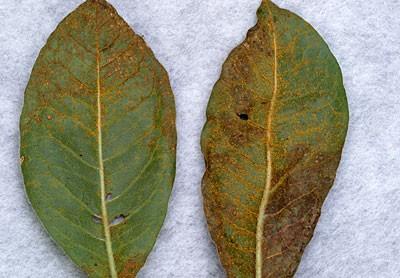
Rust on azalea leaves. Photo: David L. Clement
Key points
- Deciduous azaleas are the primary group of broadleaved shrubs damaged by rust.
- Of the six rusts in North America, the hemlock-blueberry rust, Puccininastrum vaccinii, is the most common rust infecting deciduous azaleas in Maryland. It is only sporadically severe.
- Symptoms are easily recognized by the brightly colored yellow-brown spores present in disease pustules on the lower or upper surfaces of leaves.
- Another rust, occurring on blackberry, has bright orange spores on the underside of the leaves.
- Infected plants lose their leaves prematurely and show reduced growth. Other fungi may then attack weakened plants causing further injury.
- This rust also causes yellowing and leaf or needle drop on blueberry and hemlock.
Management
- Cultural practices such as removal of diseased leaves and proper plant spacing to maximize air circulation provide the best control.
- Selected use of fungicides should be considered only leaf loss is severe. Registered fungicides include sulfur and Bordeaux mixture.
- Problems with rust can be prevented or reduced by planting resistant varieties. Deciduous Azalea cultivars resistant to rust include "Red Velvet", "Buzzare", "Rapture", "Red Letter", and "Balzae".